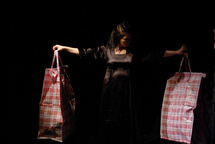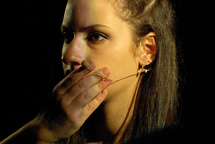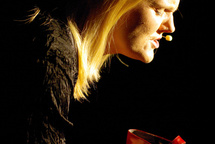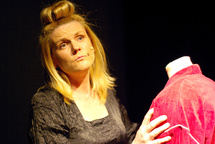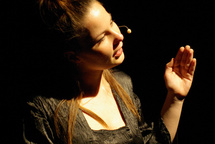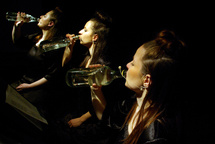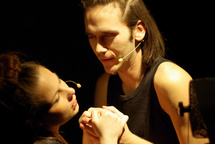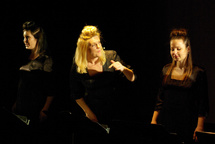Spixody/Stripsody 3
It's true, a shout is loud.
Press
… a convincing expedition to a new sensing of sounds, vocal techniques, different value hierarchies in the arts …
Večer
… the path that Karmina Šilec has walked so far is pioneering and worthy of admiration …
Dnevnik
… an important refreshment … aesthetics which seduces with its wit, inventiveness and caricature of trendy reality and the history of culture …
Delo portal
... the performance is perfectionistic ... the interpretation is so convincing that it captivates ...
Večer
… an achievement we can all be pleased about … also on the international level …
Večer
… Spixody, the last in the trilogy, is hilarious …
Delo
… and so again we were witnesses to brilliant "execution" …
Dnevnik
… an ambitious plan trying to meaningfully involve theatrical dimension which additionally underlines the ambivalence between the musical and the verbal …
Dnevnik
Similarly, the idea of blurred boundaries is transformed in Karmina Šilec and Ensemble!Kebataola!’s performance of Stripsody from 2005. In an hour-long con- cert (taking its name from Berberian’s work), the performance is made up of works running into one another, interspersed with the nine songs that make up Cage’s Sonnekus2. Each time one of the songs of Sonnekus2 is performed, a black curtain lifts to reveal the silhouette of a seated figure in front of a dark red rectangle. From the silhouette, we can see that the figure has their hand up over their mouth. As the figure is revealed, the figure’s hand slowly comes down to rest on his knee. After singing the first of the songs (over the top of Satie’s chanson Je te veux15 performed by a disembodied female voice with an unseen piano), the countertenor (the only male in the concert) places his hand back over his mouth. The spotlight slowly disappears, leaving his silhouette once again, before a black curtain descends in front of him. Each time the figure returns to sing the next movement from Sonnekus2, the same ritual is repeated. The sing- er’s gesture of placing their hand over their mouth associates the performance with Sequenza III, in which the mouth being covered by the singer’s hand plays a significant role, both visually and acoustically. The gesture in the context of Ensemble! Kebataola!’s Stripsody serves to both draw attention to the fact that the score for the work asks the singer to ‘build in long pauses’ in between each of the songs (thus fragmenting the mesostic into separate sections) and also draws our attention to the relationship between the title of their concert (Stripsody) and Berberian, through a gesture in Sequenza III. In between each of the movements are works by Morton Feldman, Adriana Hölszky, Erik Bergman, Roger Marsh, Arne Mellnäs, Erik Satie, Cathy Berberian, Daryl Runswick, Claude Lenners, Jovanka Trbojević, including Berberian’s work Stripsody, but Sequenza III is not itself performed. Yet there is a further connection to the work. After John Cage’s Aria, which is the final work of the programme, the audience claps and the singers come onto the stage and stand in a row ready to take a bow, following the normal concert convention. They take two bows before everybody except the director of the group leaves the lit stage. The director then takes a bow before leaving the stage herself. The audience continues to clap. All of the singers come back onto the stage, and the audience waits for them to bow a third time. Instead, while the audience continues to clap, the singers then all raise their hands and start clapping, themselves, as they begin to perform Steve Reich’s Clapping Music. The audience reacts by stopping their clapping abruptly when they realise the boundary of another work has emerged. This reaction, and the way in which the ensemble play with the blurred boundaries of each separate work, as well as the way in which the edges of the contained concert are blurred, poses the same philosophical question as performances of Sequenza III. That the sequenza is not specifically performed does not lessen the relationship between the practices, and it is only in performance that this relationship is revealed. The extension of Sequenza III, to Sequenza-III-ness is essential, since it reinforces the way that the composition is never the composition. Ellen Hooper, Singers, Scores and Sounds: Making New Connections and Transforming Voices, Routledge Research in Music

